For years, a pair of companies and even a couple of big RV industry names have been promising to launch revolutionary new camper-trailers equipped with their own drive motors. These motors are meant to reduce the load on the tow vehicles hauling them down the road. Well, the trailers have finally reached production. We already know that earlier this year, Pebble successfully put the Flow self-propelled camper into production; now, the other company with an innovative design, Lightship, has put its Lightship AE.1 into production. This camper, like the Pebble, teases a future where EVs can haul campers across America without range anxiety.
The two companies now selling self-trailering technology are Lightship and Pebble, and both explore the “what if?” this concept presents. What if you could tow a big camper and keep most of your range or fuel economy? What if your camper had a large battery that powered everything inside it? What if campers didn’t look so boring anymore?
Even if you disagree with the premise of these two campers, you sort of have to be impressed that both of these companies actually reached production. Automotive and RV graveyards are littered with ambitious upstarts that sold big ideas and then fizzled out without creating anything tangible. Startup companies flop so often and so hard that disbelieving these companies is often the default for so many people. I mean, how many people are currently driving an Elio? So, at least to me, it’s always commendable when a team pulls it off, and creating what’s more or less a self-pulling camper is no easy feat.
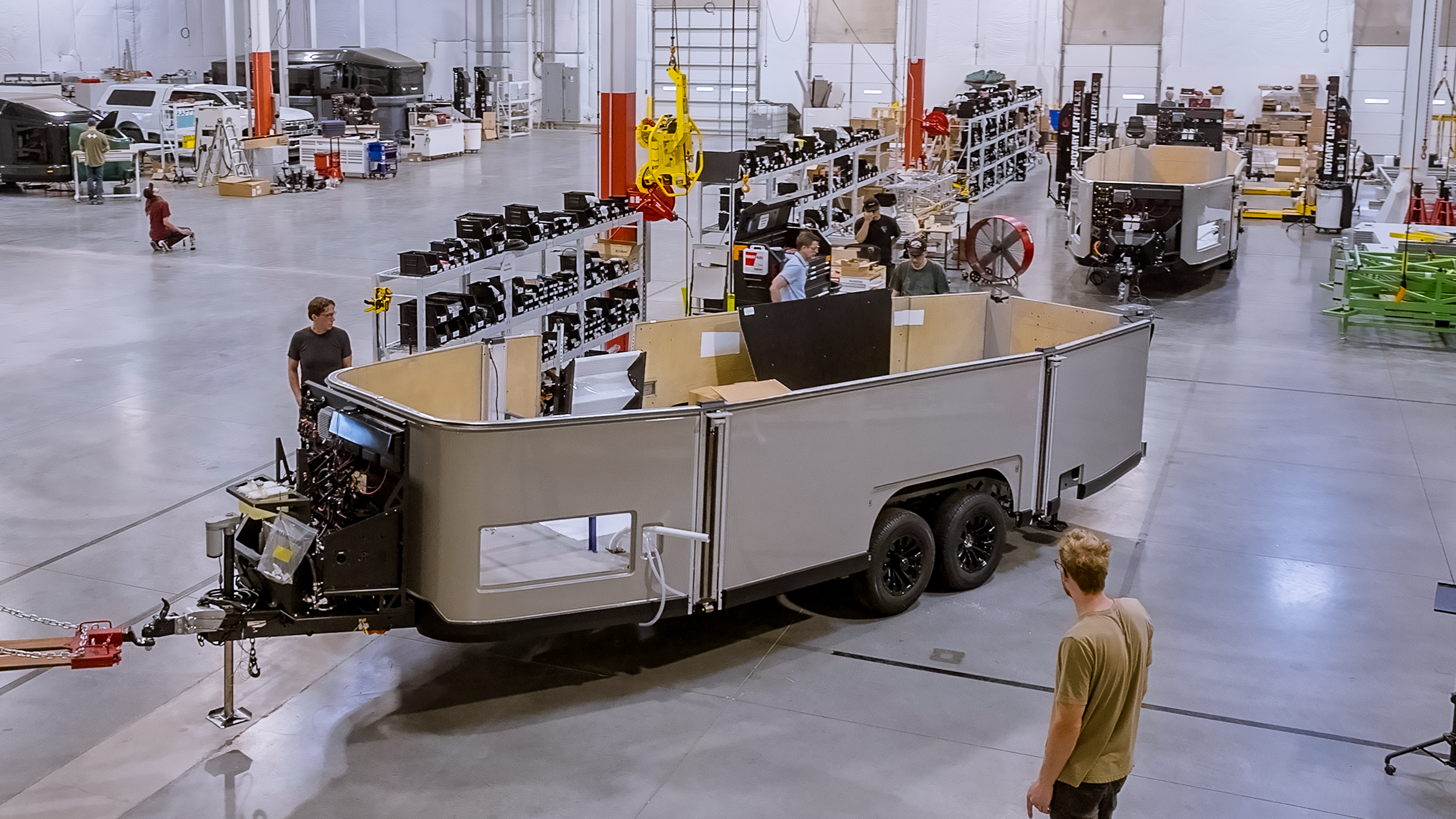
America Now Has Two Motorized Travel Trailers
Whether the folks of Lightship and Pebble knew it or not, they were more or less racing to see who could reach production first. Pebble won the race by putting its self-propelled camper into production back in the spring. If you want to read about the Pebble Flow, I’ve written about it pretty extensively.
The one camper I’ve written about even more is the Lightship AE.1, the production version of the Lightship L1 prototype, and I wrote a huge over 6,000-word piece about it back in January. That story has everything you might possibly need to know about the Lightship, but I will include the most important details in this story.

Let me set the stage. The weather has warmed up, seasonal campgrounds have reopened, and you just de-winterized your camper. If your truck is an EV, you probably limited yourself to campgrounds that aren’t too far from home. If it’s a gas truck, you’re blowing tons of money on fuel, as you’re lucky to do better than 10 mpg.
Once you’ve emptied your bank account just driving, it’s time to set your stabilizers down and kick back, right? Well, if you’re camping in a place without shore power and you have other campers near you, be prepared to hear generators cutting through your serene relaxation. Even I unintentionally became one of those generator jerks this summer.
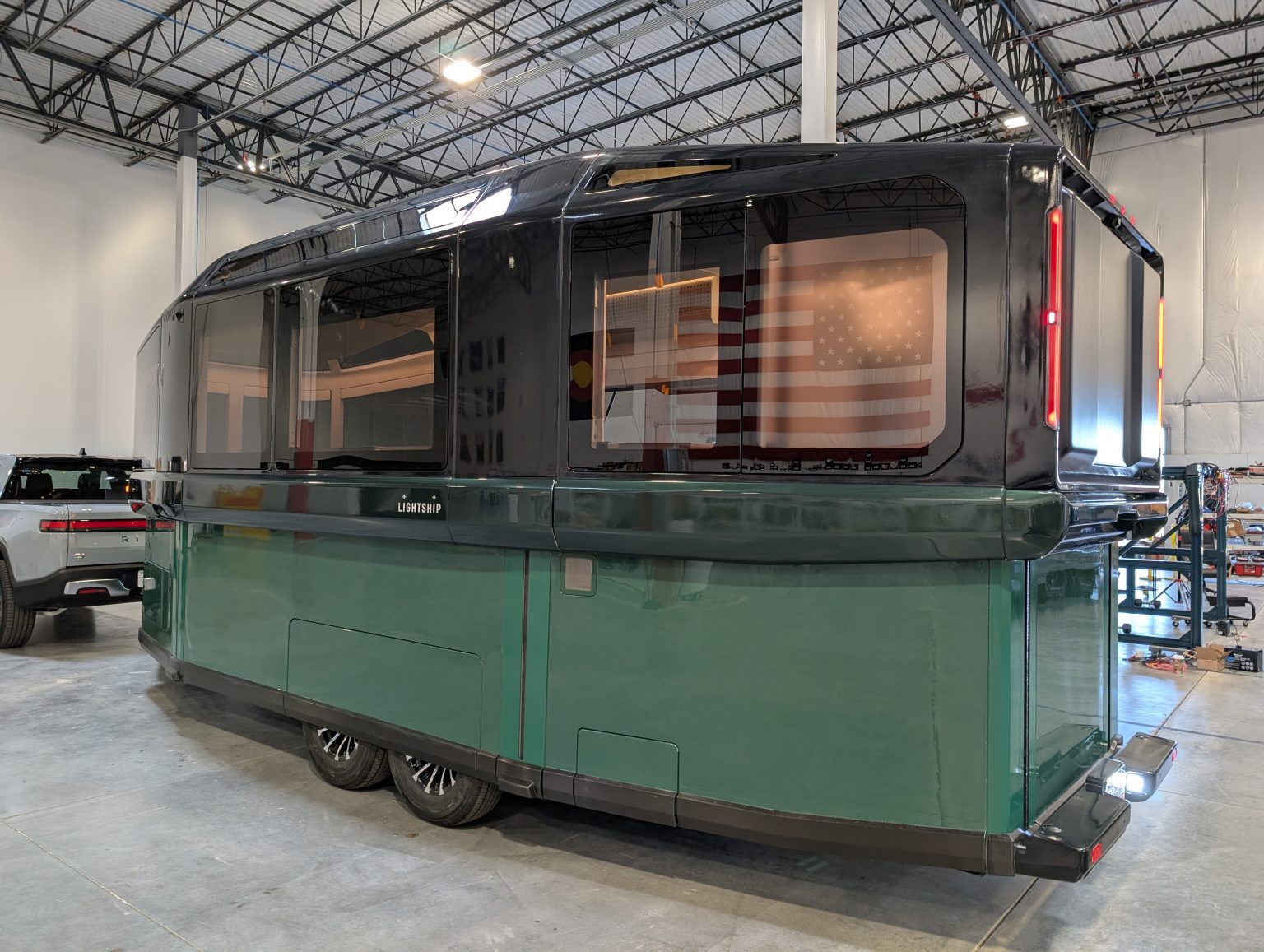
So, now you’re pissed off from having spent all of this money just to listen to a single-cylinder engine gnawing away at a tank of gas, and that’s before you learn what’s fallen off of your camper on this trip.
This isn’t me just making things up for dramatic effect, either. My family is full of lifelong travel trailer owners, and it’s shocking how much hasn’t changed over the decades. Nobody really enjoys leveling and stabilizing their trailer. Few people enjoy sliding their trailer into a narrow parking spot. Many people, myself included, would prefer to just drop the trailer’s tongue and get right to enjoying camping.
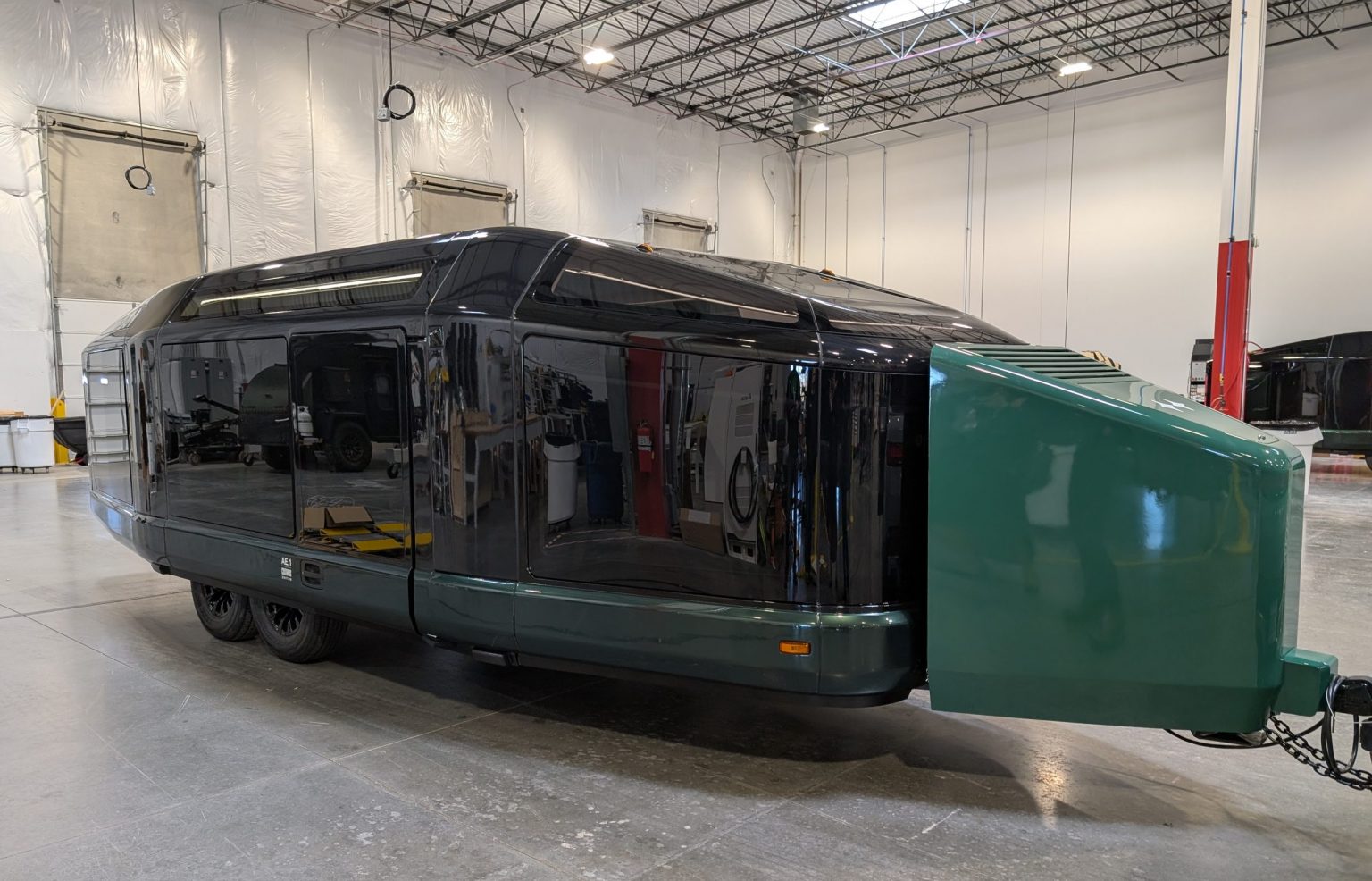
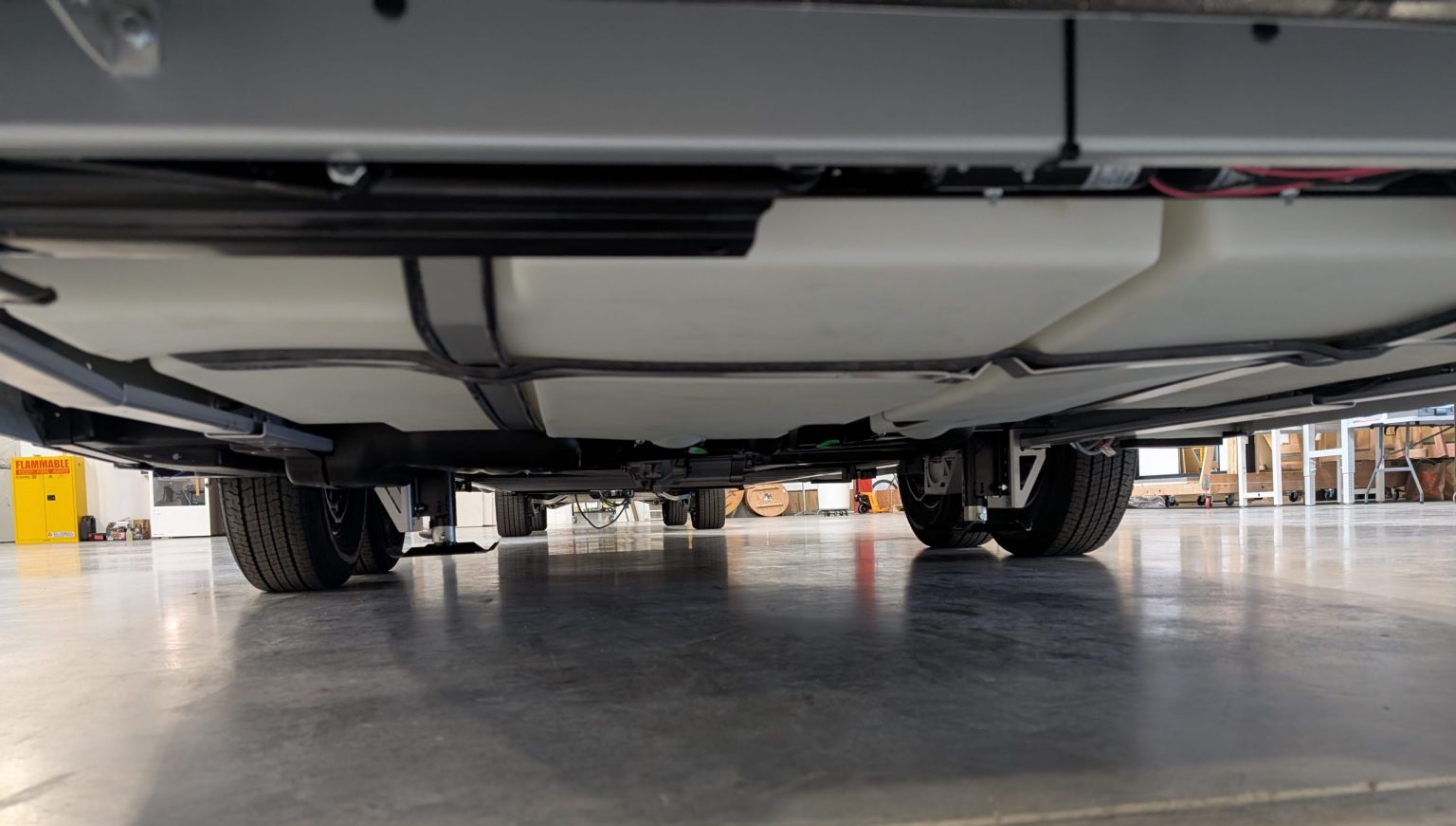
When I saw the Lightship AE.1 in person, I was blown away by how well it was put together. I wondered how on Earth car engineers did it, and the answer was because it wasn’t just car engineers, but experts in their trades. Lightship Energy has engineers and designers from automakers and RV companies. Lightship also has plumbing experts, electrical engineers, battery engineers, structural engineers, and everyone else whose expertise is necessary to bring a project like this together.
The Lightship design consists of two main portions, the canopy and the tub. Both the canopy and the tub are made out of hand-laid composites. Lightship co-founder Ben Parker told me that it’s built a lot like a glider aircraft with a foam core with two composite skins. These composites are backed by an all-aluminum space frame. Composites were chosen not just for their low weight, but because they have been proven to last a long time on RVs. After my inspection of one of Lightship’s prototypes, I would wager a bet on a Lightship lasting longer than most rigs out of Indiana. Well, I suppose it’s no wonder that Thor Industries keeps its distance from me.
Low And Smooth
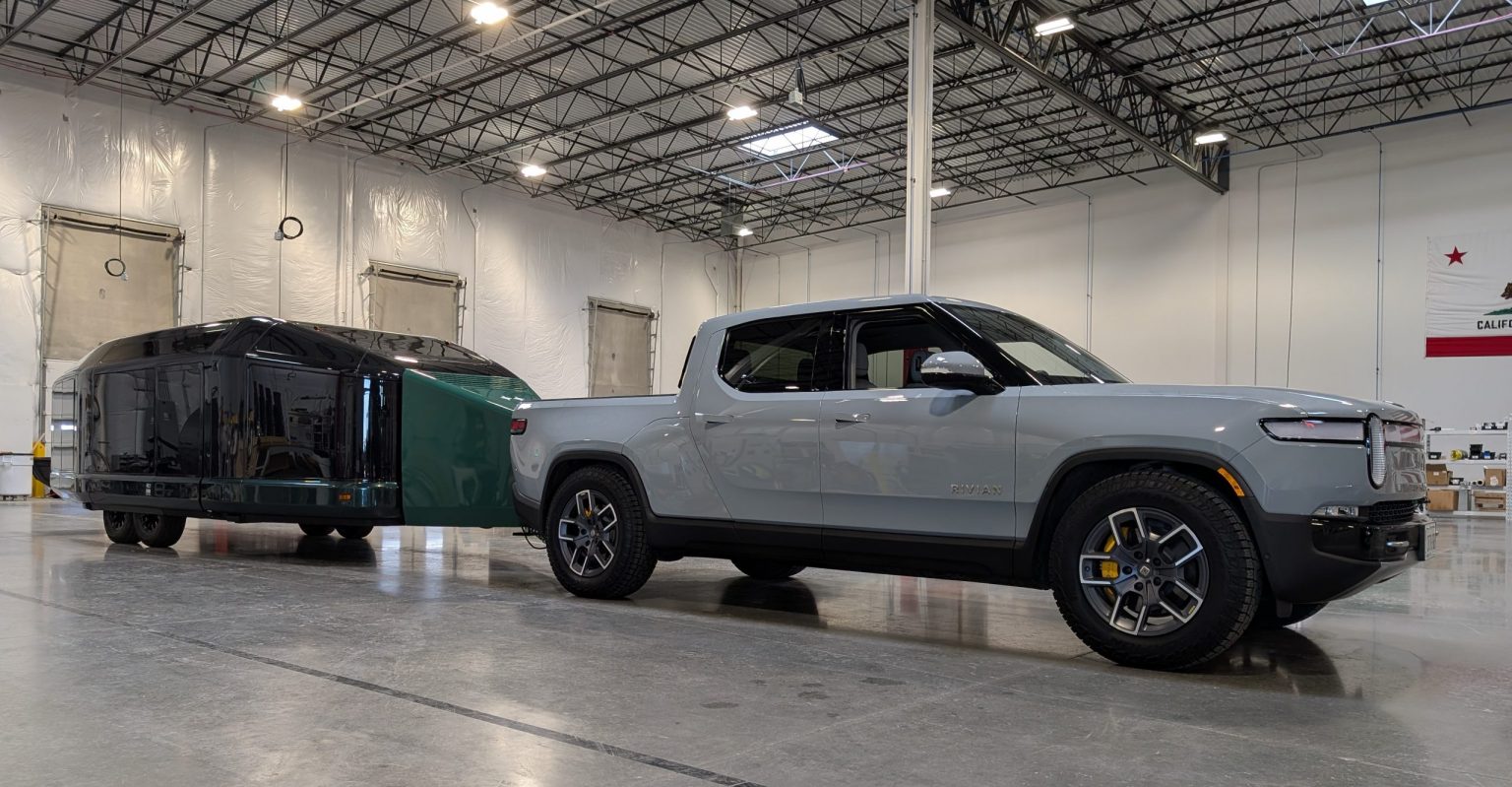
The engineers at Lightship were absolutely obsessed with a trailer that’s both big enough for the whole family while also not being a total drag. As we’ve established in one of my recent reports, aerodynamic drag is the number one killer of highway fuel economy in a gas truck and electric range in an EV. Even completely empty lightweight flatbed trailers have enough drag to bring your fuel economy down.
Traditional travel trailers are pretty much the worst offenders because they’re shaped in such a way that your truck is effectively trying to yank a small ranch house through the wind. The engineers at Lightship realized that the secret to saving range is cleaning up the aero of their trailer. Because of that, not only is the AE.1 rounded and slippery, but it compacts to almost half of its height when it’s in Road Mode. Specific dimensions from my previous piece:
[M]easuring 27-feet long, 6 feet, 11 inches tall when in road mode, and 10 feet tall when in camp mode. The trailer is said to have a ground clearance of a foot and a departure angle of just 9 degrees, so don’t take it off-road. Fully loaded, it weighs in at 8,300 pounds (dry weight is 7,450 pounds) and it sleeps 4 to 6 people depending on the configuration.

The aero means that the trailer’s motor doesn’t need to be that powerful to help the camper tow itself. The Lightship folks say that this trailer is about three times more aerodynamic than a typical travel trailer of this size, and I believe them.
The drive system is a system that Lightship calls TrekDrive. This system feeds from a 44 kWh battery pack or a 77 kWh battery pack, both of Lithium Iron Phosphate chemistry. Here are more details about that system from my previous piece:
The motor powers just the rear axle and produces 20 kW (27 HP) continuous 75 kW (100 HP) peak. The peak is for accelerating and climbing but it was determined that 20 kW was perfect for just cruising behind the tow vehicle. Parker explained that Lightship prefers making the trailer underpowered for safety. There is a suite of sensors that measure the movements of the truck. This combines with the software that works a lot like the traction control and stability control of your car to keep the trailer perfectly tensioned and in control behind your truck. But, at the same time, Parker considers the underpowered motor to be a safety feature as it the 8,000-pound trailer will never have enough power to cause havoc.
Parker explained that the team even took a test AE.1 out on the road with the motor permanently cranked up to its 100 HP peak and the worst the trailer could do was make the driver feel like something pat the truck on the butt. Otherwise, it remained stable. How is all of this legal? The Lightship team told me that while there are some legal challenges in a design like this, it’s legally considered to be the same as any other travel trailer.
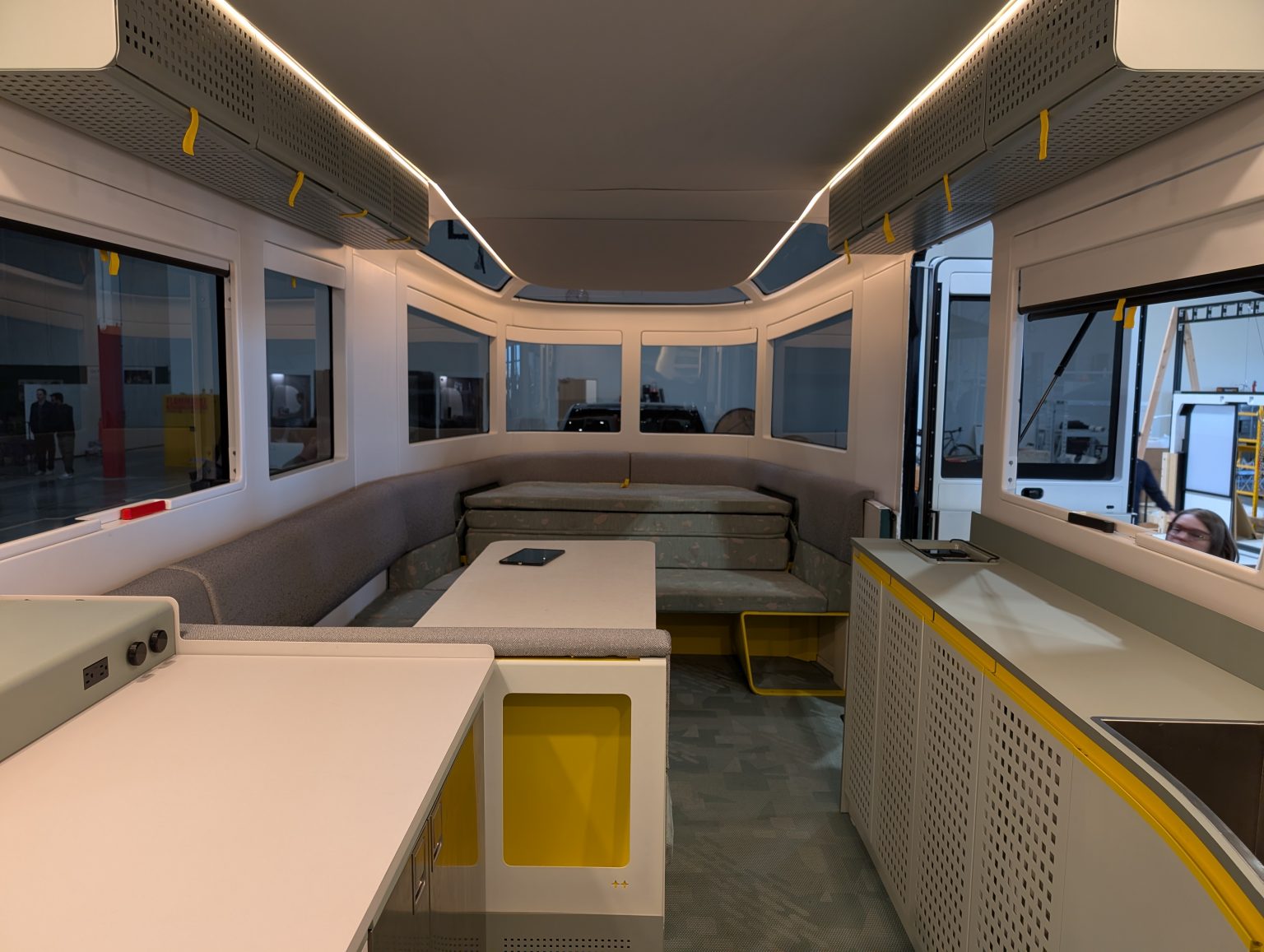
Lightship says that thanks to the 77kWh version of TrekDrive, if you pull the trailer with a 300-mile EV, that EV should keep most of its range. Likewise, if you tow the Lightship with a 20 mpg truck, then that truck should continue to get close to 20 mpg until you hit the 300-mile mark. If you exhaust the trailer’s battery, the trailer reverts to a free-wheel state. At that point, it just becomes a regular 8,200-pound gross weight trailer, but with slick aero.
The Lightship AE.1 has a camera system that can assist with parking or function as a security system. The AE.1 can also level and stabilize itself with the touch of a button. The waste tank hose is pre-installed, and it, as well as the tanks, is self-cleaning. The door is wide enough to be wheelchair accessible, and the body rides low enough that you don’t have to climb a million steps to enter.
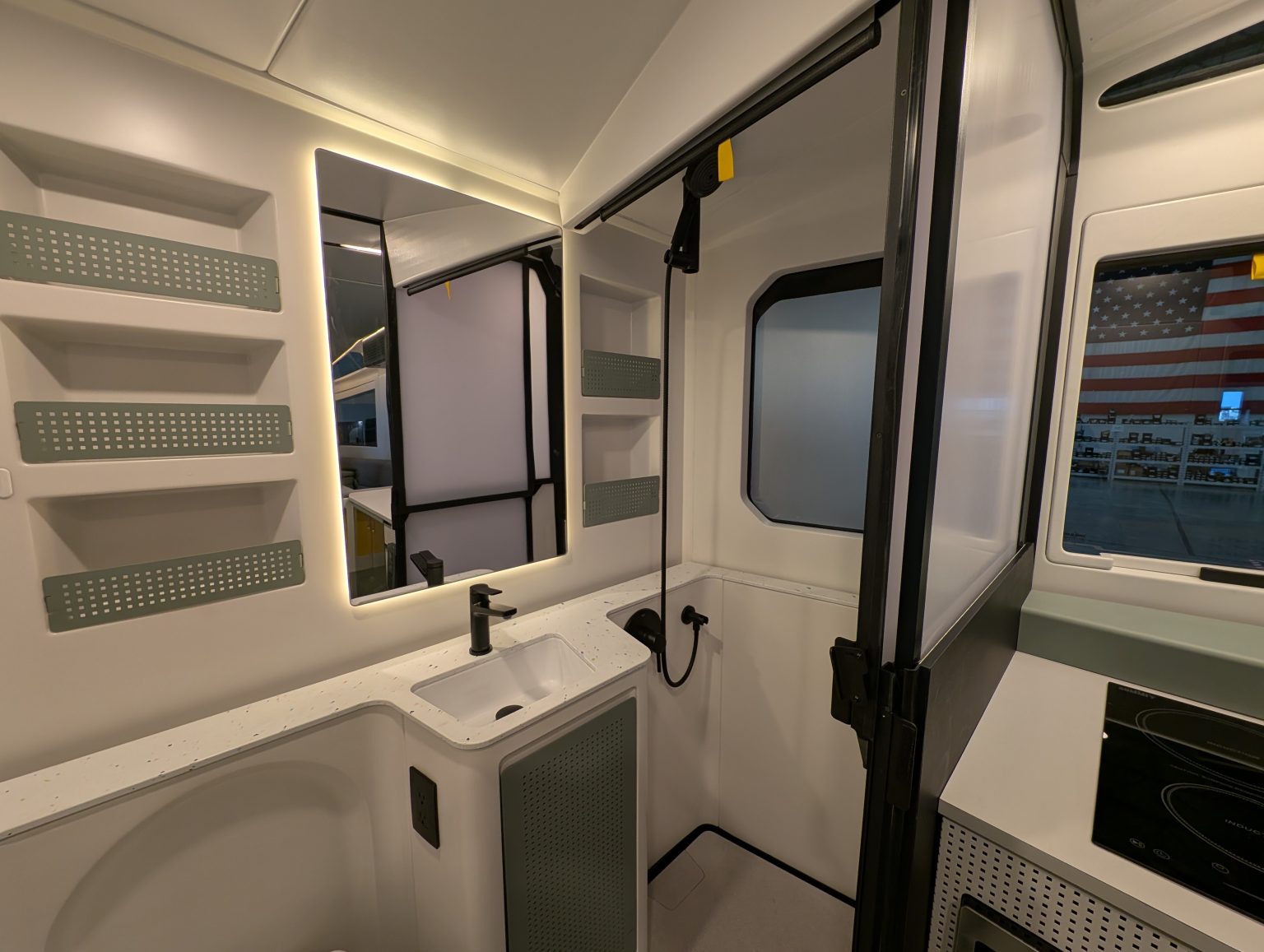

What I loved about the AE.1’s interior was Lightship’s approach to materials. The company has RV engineers in it, and these people know how nasty some RV interiors feel. Lightship went in a different direction, leaning heavily on metal, recycled plastic, and recycled fabric. But what I enjoyed most about the interior of the prototype is that high-traffic surfaces felt pleasing to the touch. The fabrics felt thick, the counters felt sturdy, and the walls didn’t feel like they would break apart if a person fell into them. I even like how Lightship baked in service panels so that both the end user and Lightship’s service people can enact easy repairs.
I was most impressed with the shower. So many typical campers have cheap showers that sit high off the floor and seemingly wrap you into a tiny, cheap plastic box while you’re trying to get clean. Lightship’s shower is flush with the floor, and you get all of the headroom afforded by the ceiling. The Lightship has up to 7.5 feet of headroom, and that’s because, as Parker told me, he wanted basketball players to be able to buy one of these and be able to relax in it without slumping their heads.
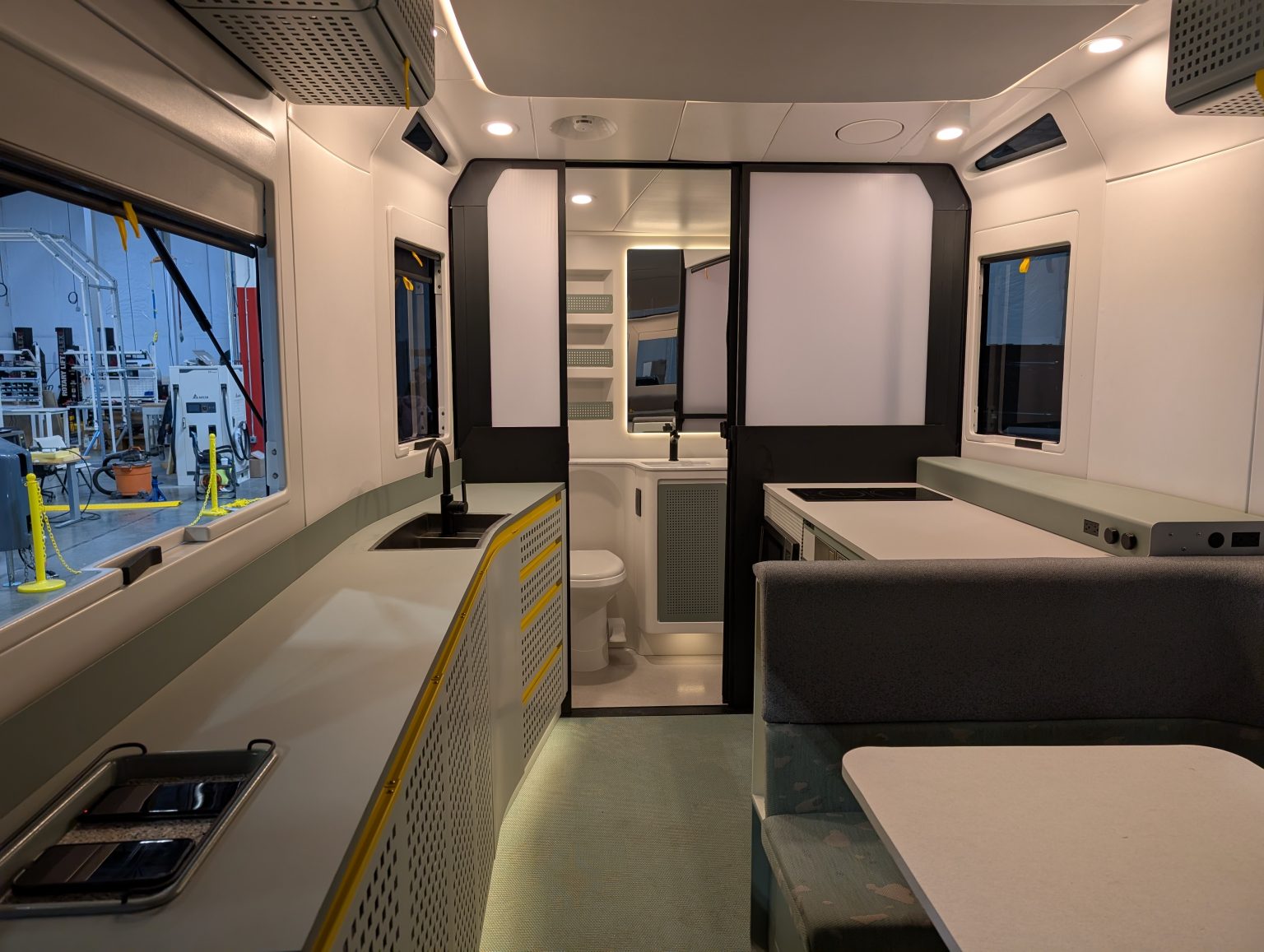
Other smaller, but neat features baked into the Lightship include a water pump with an accumulator, dark-tinted windows, window shades, and hidden HVAC vents. I’m a huge fan of that water system. If you’ve ever used the 12V electric water pump in a typical camper, then you know that these pumps suck. They don’t deliver solid water pressure, and instead sort of pulse. That doesn’t happen in the Lightship. Instead, it delivers water like the taps of a house that’s connected to city water; it’s strong and consistent.
In Production Now
The version of the Lightship AE.1 that’s in production right now is the top-spec Cosmos Edition, of which only 50 will be made. These feature 1.8 kW of solar panels, two unique colors, a dual-burner induction stovetop, a combo microwave and convection oven, a refrigerator, and a single-drawer dishwasher. In terms of tanks, the AE.1 sports a 50-gallon fresh tank, 35 gray tank, and a 30-gallon black tank.
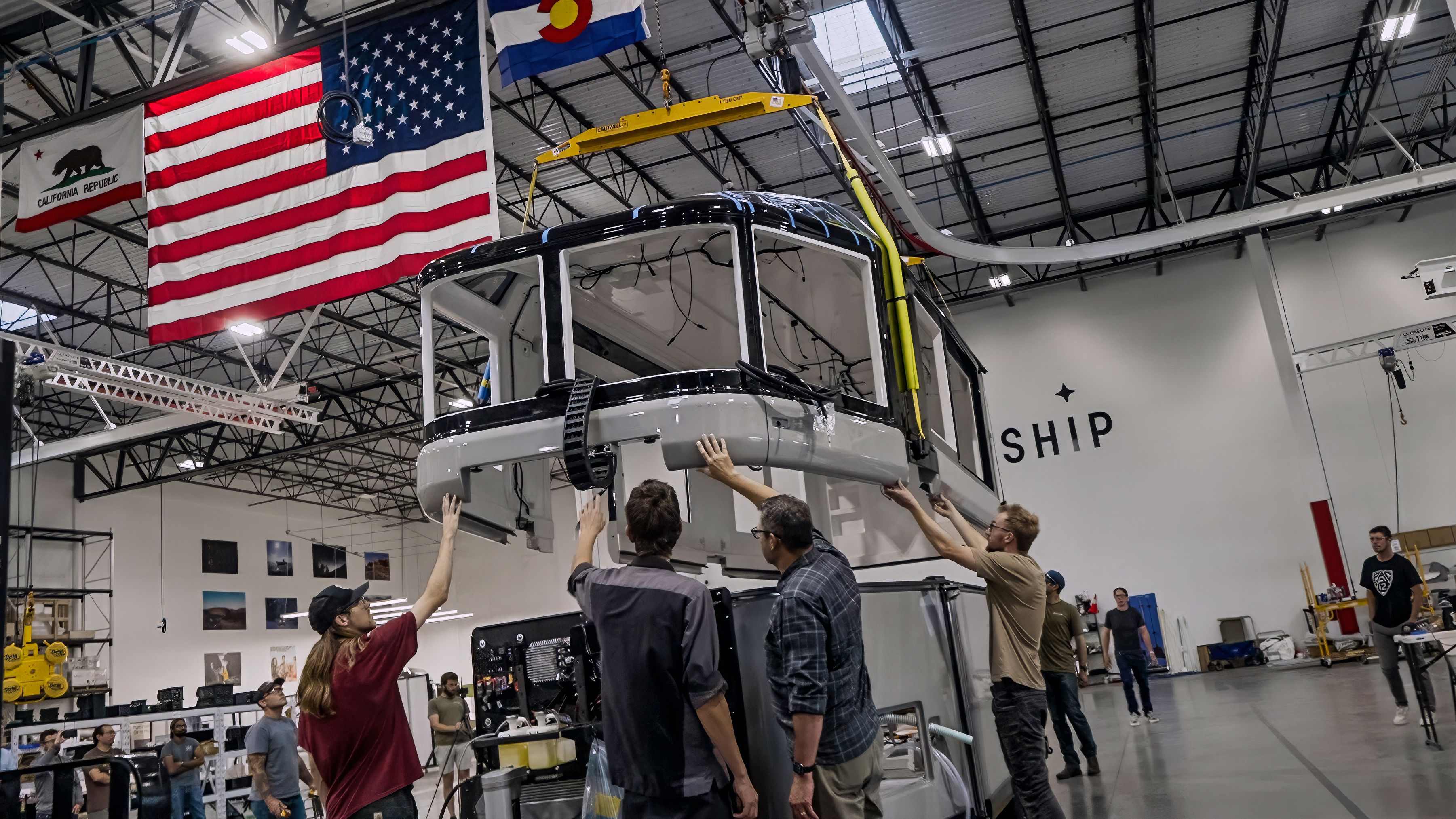
The trailer charges from a NACS port and sucks up 155 kW of juice, enabling the trailer to charge from dead to full in just one hour. The trailer can also output up to 3 kW of solar to an external source and can output 10 kW through its outlet to act like a giant generator. The folks of Lightship know that this camper will be sitting outside of your house for 90 percent of the year, so its 77 kWh battery and solar panels can feed to your house, acting like a giant Tesla Powerwall.
This trailer, which features basically every option checked, will run you $250,000. The next option down is the $184,000 Lightship AE.1 Atmos, which is the flagship 77 kWh TrekDrive camper but without the exclusive colors. It has very few option boxes to check. You can get a $2,500 motorized awning, $800 bags to go into the storage lockers in the camper, $400 for bedding, and a $7,500 twin bed that drops down from the ceiling. That’s it for options.
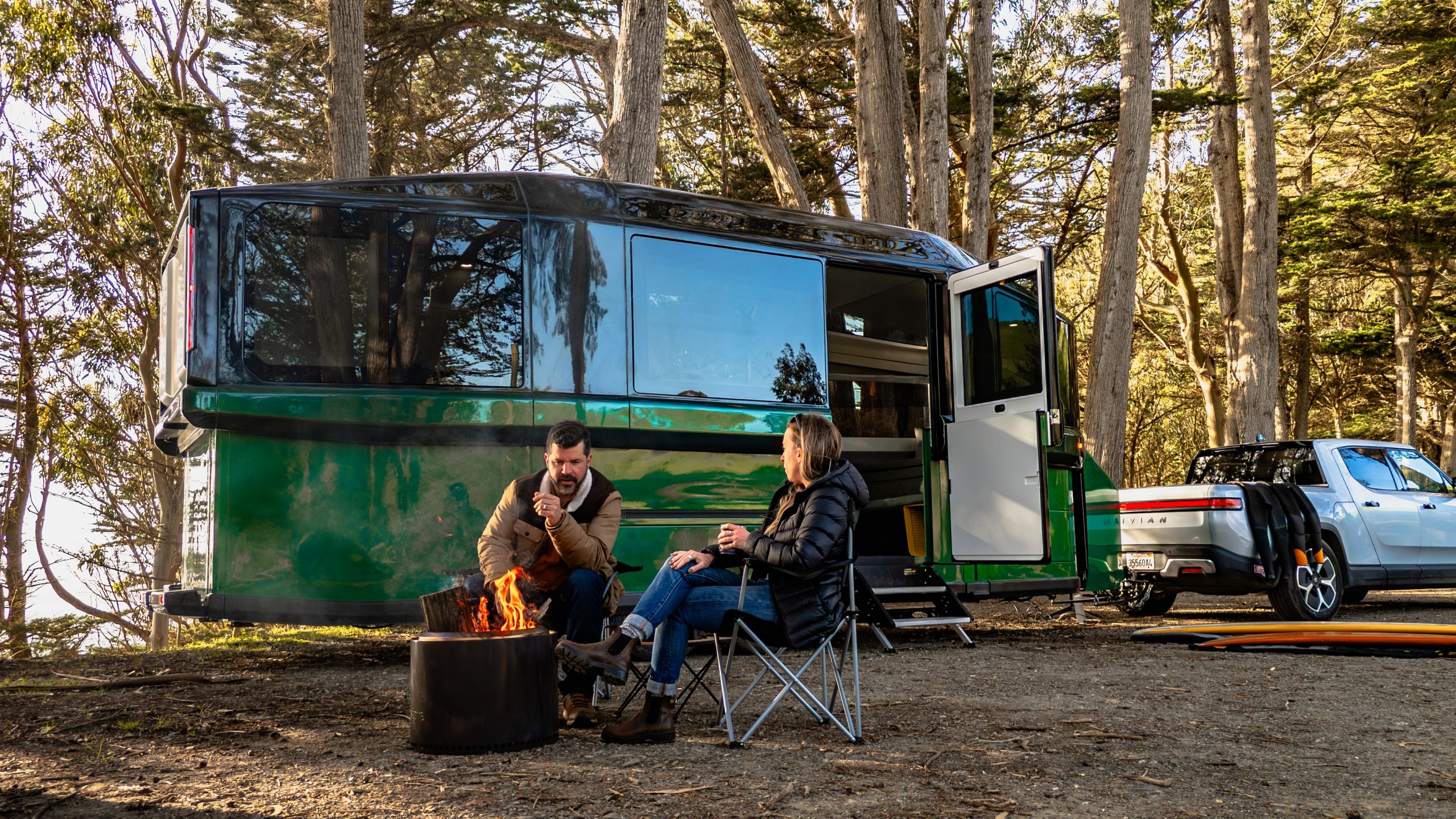
A step down from there is the $151,000 Lightship AE.1 Panos, which comes with a 44 kWh battery, TrekDrive, a slower 100 kW charging speed, and 840 watts of solar. Options include all of the options noted for the Atmos, plus the option for the system that automatically stabilizes and levels the camper, plus the camera system, which is wrapped into a single package that costs $5,000. The Panos, with its smaller battery, will go only 140 miles on a charge.
Finally, there’s the $125,000 Lightship AE.1 Terros, and this one is basically the Panos, but without the TrekDrive system. The Cosmos Edition is in production now, and deliveries begin at the end of the summer. Deliveries for the Atmos begin in spring 2026, and then deliveries begin for the Panos in late 2026.
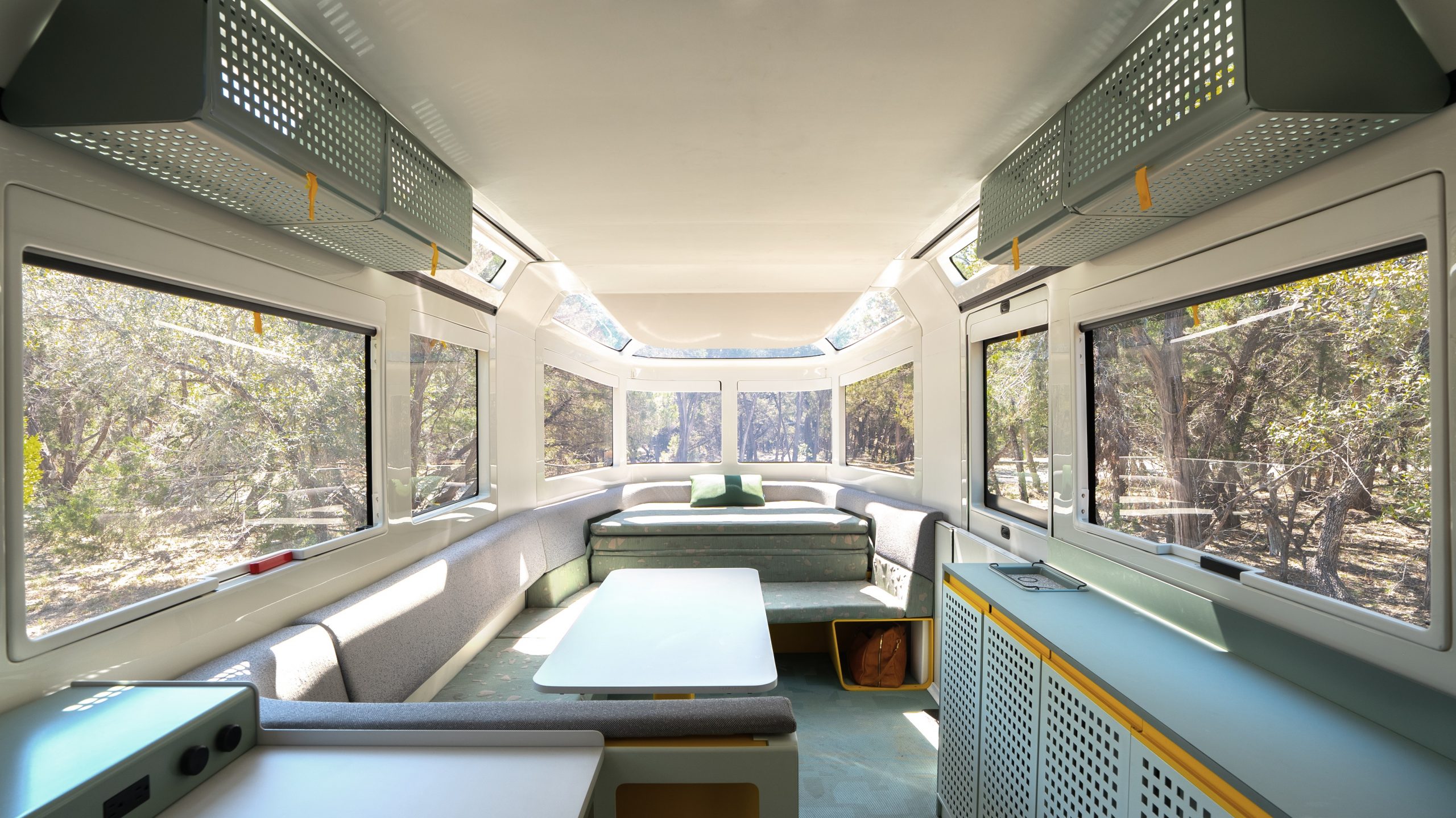
All of these prices make the Lightship AE.1 more expensive than its Pebble Flow competitor. However, it’s notable that the Lightship comes standard with features that are optional on the Pebble Flow.
Of course, the elephant in the room is America’s charging situation. Both Pebble and Lightship recognize that pull-through gas station-style charging stations are rare. Unfortunately, what this means is that when it comes time for charging, you’ll need to charge both your truck and your camper separately. Given the fact that most charging stations are parking space stalls, it will be impractical for buyers to charge their Lightships at countless stations. Then there’s the fact that public chargers often come with rates so high that operating an electric truck off public chargers costs as much as running a diesel truck. Sadly, the Lightship won’t solve that problem.
That said, I’m still excited to see this trailer finally come to market. Charging issues aside, the Lightship is packed with good ideas. I especially enjoyed the build quality. I’m not afraid to point out when an RV company sucks at quality, so if I say a camper is built well, you know I’m not fluffing it up. So, congratulations to Lightship for hitting this milestone. I cannot wait to see one in a campground.

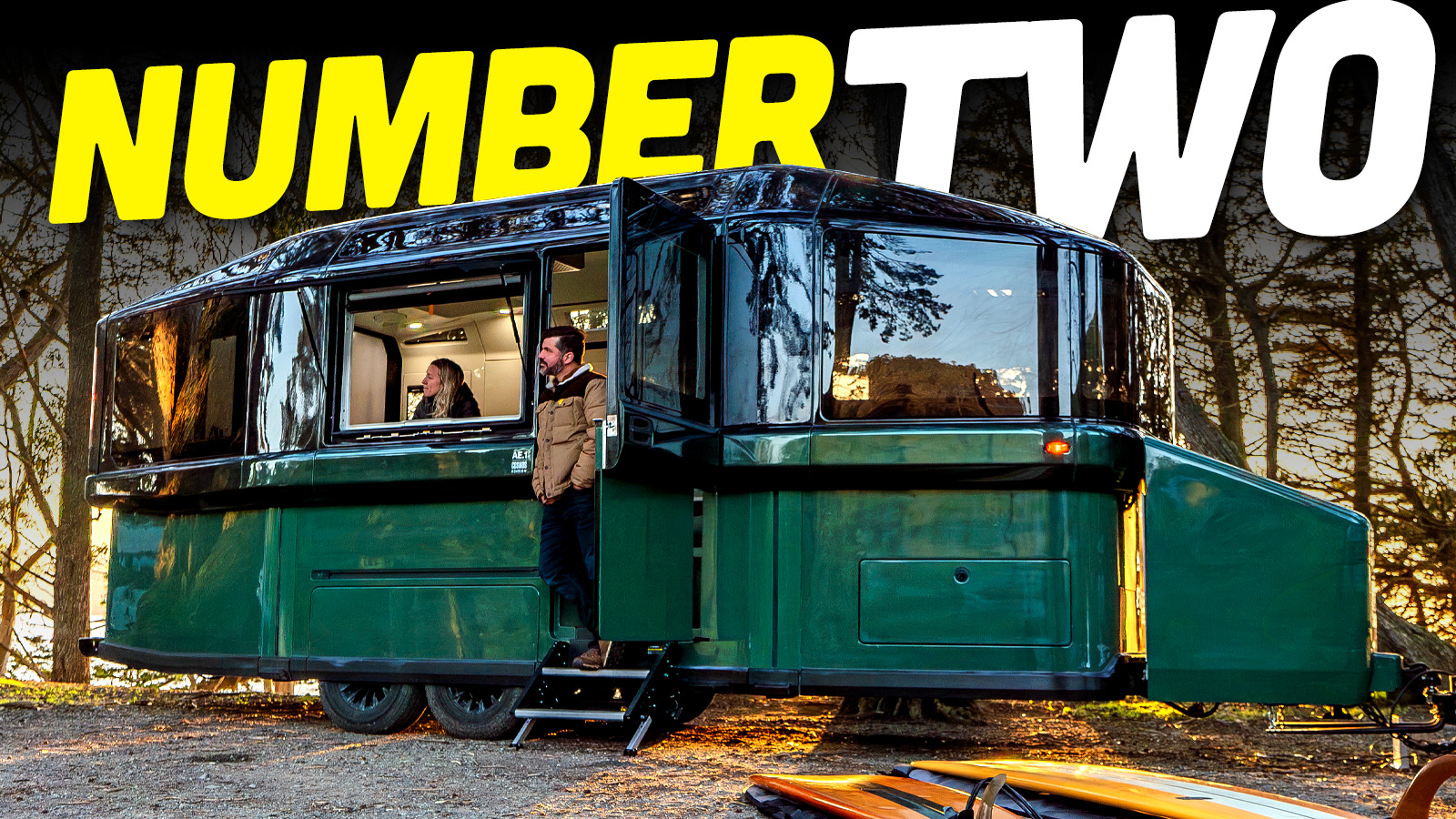







I have read all of Mercedes RV articles (and actually basically all Autopian articles since the beginning!) and love them. I have read the previous articles on these types of RV’s and they are very interesting and sound very useful. I am basically 99% anti-EV…I think EV’s are totally ugly junk trash appliances…BUT, if there was one area that would warm me to electric, THIS IS IT. I love the idea of an RV that is quiet all the time w/o a generator. I would still be one to tow this w/ a Dodge SRT-10 w/ Viper engine, or vehicle w/ V8. Gasoline forever!
A quarter million dollars for a trailer that you’ll probably have a hard time charging, with an interior that looks unfinished. The “minimalist” aesthetic seems like it’s often an excuse for tech bros who don’t have any taste of their own, so they just go for “blank” as if it were a style choice.
The exterior looks nice, though.
Interior looks pretty good to me, the styling is more more of a limitation of the materials. Regular campers that “feel like home”, are typically made out of very heavy, and very not-durable MDF/particle board cabinetry with veneers. They fall apart in normal use, disintegrate if they get wet, and are extremely heavy.
A lot of thoughtful touches and they clearly have people who actually RV working for them, but oof, that price. Unless I could use this as home energy storage I would never buy a trailer with this much battery, but even the non-battery option is 125k? Yikes!
Way cool, but way too expensive. I think that RENTING these things has some merit though; the company still owns/maintains them but they rent them out to people. The issue is, I bet most people would see how much it would cost to rent after all the maintenance and upkeep, and realize it’s WAYYYYYYYYY more per night than the absolute nicest hotel you could imagine.
Make the same thing without the complex sliding top, less glass, and modular composite sections. Then make it come without a battery or motors, but have an upgrade path that uses existing hybrid batteries and motors or something. Junkyard packs would be perfect for these types of situations; space isn’t really an issue and even if it’s a pack with only 80% capacity, it’s still going to help towing a TON, especially ifyou could get like 3-4 of them in the belly.
I’ve pondered camping and this thing is fancy, but $125k buys a lot of hotel stays. Like a good week of decent hotel rentals for the next 25 years.
Yes RV prices including initial price, use, repair, & upkeep are a LOT of hotel/Airbnb nights. When I bring that up to friends they either cannot get over using hotel toilets/bedding or have so many children/dogs that an RV is the only way to travel. We airbnb with our dogs and have no issues finding fenced yards.
When you start dividing by several children and/or pets then it starts to make a bit more sense, but as you mention there are options for places that take pets nowadays.
The previous use of amenities issue, I drank water from a garden hose so I guess my standards just aren’t up there.
That’s ~$715 per night.
$125k divided by seven nights, for 25 years. Ignoring present value of money and inflation…
Yeah, pretty nice hotel depending on the area. That being said, if you are a big camper, you can easily bring the math into your favor by using it more than seven nights a year. Use it three weeks a year and suddenly that leaves you with $238 per night, which gets you a middling (before all the fees and taxes) room in Buffalo NY… yay!
“$125k divided by seven nights, for 25 years. Ignoring present value of money and inflation…”
“That being said, if you are a big camper, you can easily bring the math into your favor by using it more than seven nights a year. Use it three weeks a year and suddenly that leaves you with $238 per night,
Clearly it depends on the person/use case. For someone who is retired or semi-retired or someone who has at least 3 weeks of vacation per year (like my dad did), with a camper it wouldn’t be unusual to do 30-60 days or more of camping per year… especially if there are other family members that might use it.
So 30 days X 25 = 750. And then it works out to $167/day… still expensive-ish, but not terrible.
I’d say something like this camper can make sense if someone does at least two months of camping per year as that then drives the cost well below $100/day.
Also I think a trailer like this can make sense when staying in rural areas where there aren’t any hotels/motels nearby.
And as 4Jim mentioned, if you travel with pets, that can also tip things in favour of an RV as the majority of hotels/motels/AirBnBs won’t accept pets.
This trailer looks to be much better built than the average travel trailer… Are we thinking that we’re actually going to get 25 years of use out of this guy?
If it’s cared for and maintained, I don’t see why not. It’s not like it would be driven on salted roads in the winter in the rust belt.
I’m surprised this is note-worthy on any modern rig. I added an accumulator to my motorhome after the first outing when I started getting an involuntary eye-twitch hearing the poor water pump trying to handle anything less than fully open taps.
I assumed it was missing just because my rig was marketed as the cheapest rig in its class back in the day and that would have added a few dollars.
I appreciate the pop-up tech, and the glassy shuttle-craft interior design which is nothing like the current FEMA trailer/Mini-Farmhouse styles prevalent in travel trailer design these days…
…but why is there a super-deep, bi-level counter across from the very long kitchen counter (Cool!) – but no dedicated bed space?
And wouldn’t it be easier to keep cool if it weren’t black and dark green?
I assume this has regenerative braking built in so that it can help you stop, too. But I do worry that “mass is mass”, and it’s still getting you closer to what your vehicle can handle in one way or another (e.g. lateral forces). Obviously, you still have to use the actual weight of this camper in determining whether it has any business being on your tow vehicle. But I fear people will start talking about things like “effective weight” that is somehow less than it’s real mass.
I’m not too worried about that, honestly. Power isn’t really the limiting factor for towing on most modern trucks anyways, especially half-tons. Payload and tongue weight are still payload and tongue weight, and for a given weight this will be more stable than average (low central center of mass, regenerative braking).
This thing is amazing. Love it. Very cool interior design, doesn’t look like an aluminum box with a stupid tribal tattoo on the side.
There it is.
It would be a lot easier to justify if I could plug this into my home solar and use the batteries as energy storage for the majority of days when I’m not camping.
Love the concept and the effort put into aero.
Yeah, that struck me as a cool idea as well.
It makes absolutely no sense at this price point, but I mean…it’s something.
You can use the camper for energy storage, from the story:
I will clean up this section to clarify that it’s designed to connect to your house when it’s parked.
Thanks. My mistake for not reading carefully enough. I am supposed to be working.
Wish them well. Should be interesting to see what the market is for this level of RV tech.
Hear me out: get a RV spot with a 50 amp service. Charge the RV, switch it to the TT30 outlet then charge the EV. Most 50 amp RV outlets I’ve run across can support 20 amps continuously. It might take a day to charge both, but that’s fine. You’re camping, not driving. A TT30 outlet can do 12 amps continuously. That’s enough to charge over a few days.
Yep, I’ve seen several EVs doing this at campgrounds this summer. And campgrounds typically don’t charge for electricity separate from the reservation. (Though I wonder if that will change in the coming years…)
That’s probably going to change. That said I’ll take the electrons while they’re not splitting out the charging. I towed my popup with my Model Y on a few trips this summer.
For those wondering what it’s like to tow
https://www.youtube.com/watch?v=8xjxc-4irxY
I’ve watched the first 12 or so minutes and something the Lightship rep struck me. Essentially “we have plans to make major improvements over time”.
Call me when you have all those improvements implemented for $250K.
I won’t be able (or willing to) afford it, at least present a finished product for $250K.
Can I assume there are or will be campers you can unhook from your truck and with a hand held remote control back the camper into a campsite parking space under its own power like a remote control toy car?
Not sure about this specific one, but I assume so. AirStream talked about that like 3 years ago when they first showed the eStream.
https://www.theautopian.com/the-airstream-estream-is-a-revolutionary-ev-powered-camper-that-can-help-tow-and-park-itself/
That’s what the Pebble does! The Lightship doesn’t have such a feature just yet.
That thing is dying to be refit into a American diner style food truck. “Roadside Burgers” or something along those lines. Neon signs poking though the windows, pancakes on the griddle, classic truck puling it from place to place. It probably has all the needed gas and water lines. It just looks perfect for it
I love this idea, and now I need to go get a good diner breakfast.
I think it’s excellent looking on the outside, and I love the windows. The pop-up concept makes a lot of sense for reducing drag, and I’m sure towing something like this versus whatever monster-sized box is a lot easier at high speeds when winds come in to play.
The interior is a little more “Black Mesa” than I would want, but at least it seems high quality (which it better be at this sort of pricing). I’m totally skeptical of the premise of self-towing EV trailers just based on the logistics of charging. I’m not sure how useful this sort of thing even is.
I guess my question is, what would this thing cost without the batteries?
I think the cheapest version she mentioned comes with batteries but without the drivetrain. So you’re probably still at $100k ditching the batteries – maybe more since you need some sort of house battery in there.
I’m curious as to how you would charge both your vehicle and this trailer. I’m assuming that it couldn’t be done at the same time, right?
If you find a lot with a bunch of empty chargers, you could probably unhook and put them into neighboring spots to charge simultaneously?
Seems like it depends heavily on the charging station you come across.
Charging would be quite difficult unless you find one of those new pull-through gas station-style chargers. As of now, most charging stations are singular parking stalls, so entirely unfriendly to an EV towing any kind of trailer. You would have to find some way to hook the camper up to one stall while hooking your truck up to another stall.
Companies like Pilot and GM are working on trailer-friendly charging infrastructure, but it’s still pretty rare. In a way, this trailer is like the Chevy Silverado EV, and its tech is more advanced than America’s charging infrastructure.
Ionna and Buc-ee’s are also excellent charging locations – they have pull through spots.
Jackknife the trailer perfectly and you can fit into two parking spaces maybe…
For the price, why don’t they have incinerator toilets? It would cure the stink of a black tank. My first thought with the first picture was, ‘Oh, an early interurban trolley!’.
Looks very Pullman.
Such a silly American thing to build: keep adding load capacity to your camper to satisfy a hoarder diagnosis until it needs its own power and couldn’t be farthest away from why it was invented in the first place. So weird.
I don’t see it straying an obnoxious distance from the goal of reducing range anxiety and eliminating a generator. Whenever someone’s generator turns on, I’m no longer a happy camper
The constant hum of multiple generators in the middle of the night in what’s supposed to be serene nature is a um, buzz-kill.
If you’re complaining about the need for electricity in the first place, rather than this product, I will give a hard disagree. Our nation’s access to varying levels/tiers of outdoors exposure is second to none. We have plenty of space and places for people to do everything from stay at the Best Western to backpack into a wilderness that they’re not even allowed to maintain with power tools. If you’re really turned off by people wanting to run fans or play music, go to a camping area where the vibe or access is different. Don’t gatekeep the outdoors. I go to a couple places where a generator is totally fine, i.e. easy access, family friendly, etc. However, I do just wish they were quieter. This product solves that issue. I support it
From where I stand, living in a congested East Coast major city, there are very precious few quiet, no-RV campgrounds. As in, none, before you get to like, Maine. And my gripe was not specifically with RVs but mostly about the extreme and constant search for creature comforts in our ‘murican society which to me seems counterintuitive to what camping should mean. Spreading the contents of a bus on a small patch of grass, 3ft away from families doing the same, is not what the marketing brochure was selling. And news just broke this morning how they are clearing rainforest to allow fancy wood trim inside – you guessed it, RVs.
The idea of driving around in an RV is sound, and extremely romantic. All I am saying is to take some compromises into account and pare the heck down man. No need to bring along your full kitchen, a lazy boy, two fridges (one for food, one for wine) and the bathtub. It’s just a one week vacation. This pastime is 100% and uniquely US-centric because we do everything to the absolute max.
I subscribe to some extent in this. I don’t call using an RV camping. Camping, to me, is tents and sleeping bags. Its supposed to be rough. Pulling portable house that is only slightly smaller than what I grew up in, and way freaking nicer, isn’t really camping. And while I fully agree there are some people who couldn’t enjoy the outdoors without some amenities (referring to those physically injured or handicapped), that is such a tiny portion of the market I would happily give them a pass. Nearly everyone pulling these things just doesn’t want to have to miss out on the comforts of home. Its not something that interests me. If I want to be comfortable like at home, I’ll just stay home. Giant trailers ruin my home town every weekend of summer, as I live in a small town that is the entrance to a large federal park.
So what’s stopping me from adding a steer axle and fold-away steering wheel and column and committing the funny
We need a hitch receiver on the back too. Self propelled RV train!
LOL! It’s my understanding that the drive system works based on what the many sensors gather about what’s happening at the tongue and elsewhere. So you’d have to figure out how to connect those sensors to an accelerator pedal, I suppose.
You know me, do you think I’d have any trouble faking any number of sensor inputs to have it do my bidding
Does it really need the complexity and cost of the motor and driveshafts, instead of just the extra batteries for the EV? And how rock resistant are those windows?
So many good details in this piece but how does a “self cleaning” tank work? Is that a common RV feature?
It uses fresh water to flush the tanks and hose. It’s not a new idea, as some campers have had such a feature already. What’s a little different is the pre-installed hose. It’s not really an “innovation,” but I suppose a nice change if you gag while installing your drain hose. 🙂